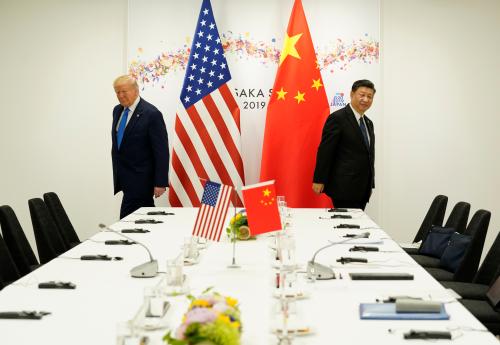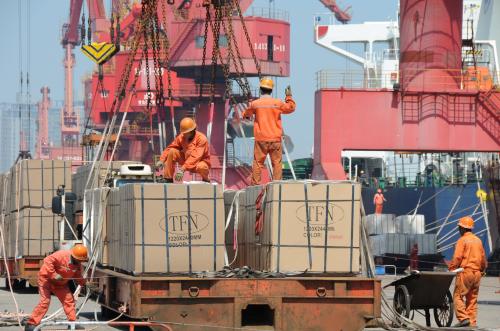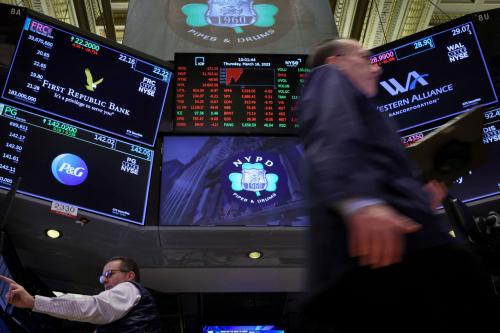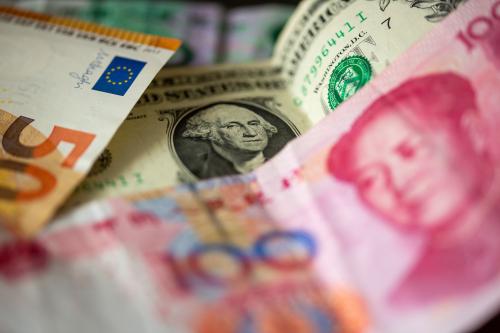For U.S.-China trade talks, continuing stalemate and negotiation seem the most likely outcome. President Trump could get frustrated with the whole process and move ahead with tariff escalation, but this would be risky, as David Dollar explains. This piece originally appeared in The Hill.
Treasury Secretary Steve Mnuchin and Trade Representative Robert Lighthizer are in Shanghai this week for trade talks. In addition to their usual counterpart, economist Liu He, the Chinese side will give a more prominent role to Commerce Minister Zhong Shan. The Chinese will probably make a reciprocal visit to the United States within a few weeks.
The main item of business is to formalize the mini-deal that emerged from the Trump-Xi meeting in Osaka: The Chinese will resume some purchases of agricultural products and the U.S. will ease up on sanctions aimed at Huawei. It is unlikely that this round of talks would result in more than that agreement because there has not been detailed negotiation at the working level in advance. A good discussion, however, could lay the foundation for further agreement later in 2019.
China’s main objective is to avoid escalation of the tariff war, in particular the threatened tariffs on the final $300 billion of Chinese exports to the U.S. They hope that the mini-deal plus ongoing negotiations will be sufficient to prevent that. Both sides may have an incentive to keep a truce in place without reaching a larger agreement.
 For China, a larger agreement would entail the U.S. rolling back all—or virtually all—the existing tariffs aimed at China in return for a larger set of purchases covering both agriculture and manufacturing, opening of sectors (already planned for autos and financial services) and language about strengthening intellectual property rights (IPR).
For China, a larger agreement would entail the U.S. rolling back all—or virtually all—the existing tariffs aimed at China in return for a larger set of purchases covering both agriculture and manufacturing, opening of sectors (already planned for autos and financial services) and language about strengthening intellectual property rights (IPR).
The Trump administration seeks much more extensive structural reforms from China—opening further markets and changes in laws to protect IPR and to reduce subsidies to state enterprises.
Giving Zhong Shan a more prominent role on the Chinese team is a signal that these kinds of concessions from China are highly unlikely. Zhong is a staunch defender of China’s interests and rights within the global trading system.
Since the two sides are far apart in terms of what would constitute a comprehensive deal, continuing stalemate and negotiation seems the most likely outcome. President Trump could get frustrated with the whole process and move ahead with tariff escalation. But this would be risky as the U.S. economy is clearly slowing down.
Growth last year was revised down to 2.5 percent in the final number, and the early estimate of second quarter growth is further deceleration to 2.1 percent. Also, if the final round of tariffs is implemented, it will include popular consumer items such as smart phones, tablets and TVs.
Alternatively, Trump could accept the deal that the Chinese are offering, which would likely provide at least a short-term boost to the economy. But he would take some criticism from both the right and the left as any deal is likely to fall short of the complete overhaul of the Chinese system that has been the administration’s objective.
Finally, there’s the question of why negotiators are meeting in Shanghai. Looking at the history of U.S.-China trade talks going back two decades, it is not unusual to meet in locations around China.
Shanghai is a center of reform and economic opening, and the Chinese press is emphasizing that this gives the U.S. team a chance to see the reality on the ground. Probably more relevant: the senior leaders are about to start their annual conclave at the seaside resort of Beidaihe. Even if Xi Jinping is still in Beijing this week, the leadership is busy with preparations. By holding the talks in Shanghai, Xi can avoid meeting the delegation without any diplomatic slight or implication.






Commentary
What a US-China trade deal could look like
August 1, 2019